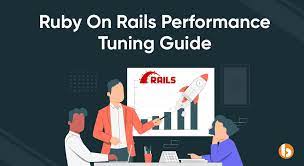Optimizing Performance in Ruby on Rails Applications: A Comprehensive Guide
Ruby on Rails, often referred to as Rails, is a popular open-source web application framework written in Ruby. It’s known for its simplicity and flexibility, making it a top choice for developers worldwide. However, as with any technology, ensuring optimal performance is crucial for a seamless user experience. In this article, we’ll explore various strategies and best practices to optimize performance in Ruby on Rails applications.
Understanding the Importance of Performance Optimization
Performance optimization in web applications is not just about faster loading times; it significantly impacts user satisfaction, search engine rankings, and overall business success. Users tend to abandon slow-loading websites, leading to higher bounce rates and decreased conversions. Moreover, search engines like Google consider website speed as a ranking factor, making it imperative for businesses aiming to improve their online visibility.
1. Conducting a Performance Audit
Before diving into optimization techniques, it’s essential to assess your application’s current performance. Use tools like Google PageSpeed Insights and Lighthouse to identify areas that need improvement. Analyze server response times, image sizes, and JavaScript execution to pinpoint bottlenecks.
2. Database Optimization
One of the critical components of a Rails application is its database. Optimize database queries, use appropriate indexes, and consider caching mechanisms to reduce database load. Utilize ActiveRecord, Rails’ built-in ORM, efficiently, ensuring minimal database hits while processing requests.
3. Caching Strategies
Implement caching strategies to store frequently accessed data and HTML fragments. Rails provides various caching mechanisms like page caching, action caching, and fragment caching. Choose the appropriate caching method based on the type of content and frequency of updates.
4. Code Profiling and Performance Monitoring
Use profiling tools like Rack Mini Profiler and New Relic to identify performance bottlenecks in your code. Profiling helps developers pinpoint specific functions or methods causing slowdowns, enabling targeted optimizations. Regularly monitor your application’s performance to detect issues in real-time and make necessary adjustments.
5. Image and Asset Optimization
Large images and unoptimized assets can significantly increase page load times. Compress images, use responsive image techniques, and leverage CSS and JavaScript minification to reduce file sizes. Consider using Content Delivery Networks (CDNs) to serve assets closer to users, improving overall loading speeds.
6. Scaling Techniques
As your application grows, scaling becomes crucial. Implement horizontal scaling by adding more servers and vertical scaling by upgrading existing server resources. Load balancing and database replication are essential techniques to distribute traffic and maintain data consistency.
7. Security and Performance
Ensure that security measures, such as protecting against SQL injection and XSS attacks, do not compromise performance. Utilize prepared statements and parameterized queries to prevent SQL injection while maintaining optimal query execution speed.
8. Mobile Optimization
With the rise of mobile users, optimizing for mobile devices is non-negotiable. Implement responsive design principles, optimize images and fonts for smaller screens, and prioritize critical content to enhance mobile user experience.
Conclusion
this comprehensive guide has illuminated the intricate landscape of Ruby on Rails application development. By delving into key techniques, from database optimization to code efficiency, developers are equipped to enhance their application’s performance significantly. Emphasizing the importance of continuous monitoring and adaptation, this guide empowers developers to navigate the evolving challenges of web development, ensuring that their Ruby on Rails applications not only meet but exceed user expectations. Armed with these insights, developers are poised to create robust, high-performing applications that thrive in the dynamic digital realm.
Frequently Asked Questions
Q1: Why is performance optimization essential for Ruby on Rails applications? Performance optimization ensures faster loading times, better user experience, higher search engine rankings, and increased business success.
Q2: How can I conduct a performance audit for my Rails application? Use tools like Google PageSpeed Insights and Lighthouse to assess your application’s current performance and identify areas for improvement.
Q3: What caching strategies are recommended for Rails applications? Rails provides various caching mechanisms like page caching, action caching, and fragment caching. Choose the appropriate method based on the type of content and frequency of updates.
Q4: How can I optimize images and assets in my Rails application? Compress images, use responsive image techniques, and leverage CSS and JavaScript minification to reduce file sizes. Consider using Content Delivery Networks (CDNs) to serve assets closer to users.
Q5: What is the significance of mobile optimization in Rails applications? Mobile optimization ensures that your application is accessible and user-friendly on mobile devices. Implement responsive design, optimize images and fonts, and prioritize critical content for smaller screens.







